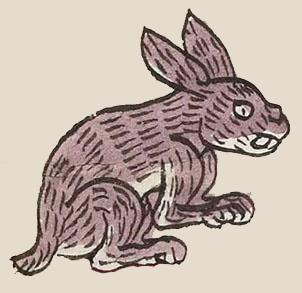tochtli (Mdz50r)
This element of a rabbit (tochtli) has been carved from the compound sign for the place name, Tochtlan. It shows a full-bodied rabbit in profile, facing the viewer's right, and crouching somewhat. Its coat is purple-gray, mottled, white on the underbelly and lower side of the chin. Its visible eye is white and open, and it has protruding white teeth.
Stephanie Wood
Of course, rabbits were a regular feature in the countryside. But rabbit was also a year and a day sign in the calendars. The shape visible in the moon is also a rabbit, and rabbits had an association with the alcoholic beverage (octli), called pulque in Spanish, made from the agave.
Stephanie Wood
c. 1541, by 1553 at the latest
Stephanie Wood
conejos, rabbits, animales, xiuhpohualli, año, turquesa, xihuitl

el conejo
Stephanie Wood
Codex Mendoza, folio 50 recto, https://digital.bodleian.ox.ac.uk/objects/2fea788e-2aa2-4f08-b6d9-648c00..., image 110 of 188.
The Bodleian Libraries, University of Oxford, hold the original manuscript, the MS. Arch. Selden. A. 1. This image is published here under the UK Creative Commons, “Attribution-NonCommercial-ShareAlike 3.0 License” (CC-BY-NC-SA 3.0).


